Picture this: you’re behind the wheel, cruising down a narrow, winding lane. Ancient stone walls line the road, and just beyond them, rolling green hills stretch as far as the eye can see. A village with charming, thatched-roof cottages appears in the distance. This is the very essence of an English countryside vacation—a self-drive adventure where you set the pace.
Why Choose an English Countryside Vacation
Let’s be honest, rigid tour schedules and packed buses aren’t for everyone. A road trip through the English countryside is all about freedom and a sense of personal discovery. It’s the simple joy of pulling over for an impromptu picnic next to a babbling brook or deciding to spend an extra hour exploring a village that has completely captured your heart.
This isn’t just a holiday; it’s a story you write for yourself, one mile at a time. The real magic happens in those unscripted moments—the hidden gems you find tucked away between the famous landmarks. You get to build a trip that is genuinely yours, whether you’re a history aficionado, a dedicated hiker, or just someone looking for a bit of peace.
A self-drive tour offers something a guided trip simply can’t: the pure joy of serendipity. The best memories are often the ones you didn’t plan for—that cozy pub you stumble upon or the scenic viewpoint you discover completely by chance.
Before we dive into the details, let’s look at the key ingredients that make for an unforgettable countryside trip. Think of these as your core building blocks for planning the perfect adventure.
Key Elements of a Perfect Countryside Vacation
| Element | Why It’s Important | Top Tip |
|---|---|---|
| Flexible Itinerary | Allows for spontaneous discoveries and a relaxed pace. | Plan your main overnight stops, but leave daytime hours open for exploration. |
| Right Vehicle | Roads can be narrow, so a smaller car is often better. | Opt for a compact car for easier navigation and parking in small villages. |
| Characterful Accommodation | Staying in pubs, inns, or B&Bs enhances the local experience. | Book well in advance, especially in popular areas like the Cotswolds or Lake District. |
| Local Food & Pubs | A huge part of the cultural experience is enjoying a Sunday roast or a pint of local ale. | Don’t be afraid to ask a local for their favourite pub—they always know the best spots! |
| Embracing the Unexpected | The best moments often come from unplanned detours. | If you see an interesting-looking sign or a scenic lane, follow it! |
A well-planned trip balances these elements, giving you a framework for adventure without taking away the freedom that makes it so special.
A Destination with Timeless Appeal
The charm of the English countryside isn’t a recent trend; it’s something that has drawn people in for generations. This enduring appeal is backed by some serious numbers. For instance, the UK was forecasted to welcome 41.2 million inbound visits, bringing in an estimated £31.5 billion from international tourists, with those figures expected to keep climbing. You can dig into these trends over at VisitBritain.
What this popularity means for you is a well-oiled machine ready to welcome independent travellers. From cosy B&Bs to historic inns, the infrastructure is fantastic. This guide is designed to give you all the practical advice and insider tips you’ll need, making sure you feel confident and ready to hit the road.
If you’re just starting to map out your journey, exploring our detailed guides on travelling across England is a great place to begin. It’s the perfect resource to help turn that dream of an English countryside escape into a real, memorable itinerary.
Crafting Your Perfect Self-Drive Itinerary

This is where the real fun begins. Your self-drive tour is your vacation story waiting to be written, with each stop a new and exciting chapter. Planning this journey shouldn’t feel like a chore; it’s about connecting the dots between charming villages, ancient castles, and stunning national parks to create an adventure that is entirely your own.
Think of your itinerary as a flexible blueprint, not a rigid set of rules. The real goal is to have a solid structure—knowing where you’ll be sleeping each night—while leaving plenty of room for those spontaneous detours that make an English countryside vacation so magical. This approach takes the stress out of last-minute scrambling but keeps the spirit of adventure alive and well.
Your first big decision is choosing which part of England you want to get lost in. Every region has its own distinct personality, and the right choice depends completely on the kind of experience you’re craving.
Choosing Your Ideal Region
England’s countryside isn’t one single landscape but a rich patchwork of different areas, each with its own character and allure. To find your perfect match, think about what you really want from your trip.
- For Storybook Charm: The Cotswolds. If you’re dreaming of honey-coloured stone cottages, gently rolling hills, and villages so perfect they look like they’ve been plucked from a film set, the Cotswolds is for you. It’s postcard England, come to life.
- For Dramatic Landscapes: The Lake District. For those who crave epic scenery, winding mountain passes, and breathtaking lakes, this national park delivers high drama and some of the best hiking in the country.
- For Rugged Coastlines and Legends: Cornwall. Head southwest for wild Atlantic coastlines, hidden smugglers’ coves, ancient myths, and a unique Celtic culture. It’s a land of surfers, artists, and tin-mining history.
- For Wild Moors and Dales: The Yorkshire Dales. Picture vast, windswept moors, dry-stone walls crisscrossing the hillsides, and warm, welcoming pubs tucked away in traditional farming communities. That’s Yorkshire.
Once you’ve picked a region, you can start mapping out a route that makes sense. The key is to avoid cramming too much into one day. A great rule of thumb is to limit your driving to 2-3 hours per day. This gives you plenty of time to explore, eat, and just wander without feeling rushed.
Navigating the Roads and Choosing Your Car
Driving in the English countryside is an experience in itself. The roads are often narrow, twisting, and lined with ancient hedgerows. While this is a massive part of the charm, it does require a little preparation.
First, the car. A big, comfy vehicle might seem like a good idea, but trust me, a smaller, compact car is almost always the better choice. It makes navigating tight village streets, finding a parking spot, and squeezing past oncoming traffic on single-track lanes so much less stressful.
A crucial tip for driving on rural roads is to anticipate and use the designated “passing places.” These small pull-outs are your best friend on single-track lanes. A friendly wave to a driver who lets you pass is a much-appreciated part of local driving etiquette.
It’s also a good idea to get familiar with UK road signs. Most are intuitive, but you’ll want to know the national speed limit sign (a white circle with a black diagonal stripe) and signs for narrow roads. A reliable GPS is a must, but downloading offline maps is a smart backup—mobile service can be spotty in the most beautiful, remote areas.
Sample Itinerary: A 7-Day Cotswolds Dream
To give you a clearer picture, here’s a sample itinerary that balances driving with discovery. You can use this blueprint as a fantastic starting point for building your own journey.
A Week in the Cotswolds
| Day | Main Stop(s) | Key Activity | Evening Base |
|---|---|---|---|
| 1-2 | Cirencester & Bibury | Explore the Roman history of Cirencester and visit the famous Arlington Row in Bibury. | Cirencester |
| 3-4 | Bourton-on-the-Water & The Slaughters | Enjoy the lively atmosphere of Bourton-on-the-Water, then take a peaceful walk to Upper and Lower Slaughter. | Stow-on-the-Wold |
| 5 | Broadway & Chipping Campden | Visit Broadway Tower for incredible views and explore the historic market town of Chipping Campden. | Chipping Campden |
| 6-7 | Castle Combe & Lacock | Discover what is often called England’s prettiest village, Castle Combe, and the historic Lacock Abbey. | Castle Combe |
This plan lets you soak in the region’s highlights without feeling rushed. You can easily adjust it to squeeze in a visit to a classic English garden or spend a lazy afternoon enjoying a proper cream tea.
For those who prefer a more structured approach or want ideas for other regions, checking out professionally planned self-drive tours in England can provide amazing inspiration and ready-made routes. These expertly crafted itineraries take the guesswork out of planning, letting you focus on the adventure.
Choosing Your Ideal Countryside Accommodation
Where you lay your head at night is more than just a place to sleep; it’s a huge part of what makes an English countryside vacation so special. Forget the predictable, cookie-cutter hotels. The real charm lies in the unique, character-filled lodgings that are as much a part of the experience as the landscapes themselves.
The right accommodation sets the tone for your entire trip. It can be the difference between simply visiting a place and truly feeling like you’re a part of it. Choosing a cosy inn over a generic chain hotel isn’t just about comfort; it’s about cultural immersion.
From Cozy B&Bs to Grand Country Houses
Think of your accommodation as your home base for adventure. Do you want the friendly, personal touch of a family-run Bed & Breakfast or the total freedom and privacy of your self-catering cottage? Each option offers a completely different flavour of countryside life.
Let’s break down the main contenders to help you find the perfect fit for your travel style and budget.
- The Traditional Bed & Breakfast (B&B): This is the quintessential countryside experience. You can expect a warm welcome from your hosts, a comfortable room in a private home, and a hearty, home-cooked “full English” to start your day. It’s ideal for travellers seeking local insights and a personal connection.
- The Self-Catering Cottage: Imagine having your own stone cottage, complete with a kitchen and a roaring fireplace. This option gives you maximum freedom and privacy. It’s perfect for longer stays, families, or couples who want to cook their own meals with fresh produce from local farm shops.
- The Historic Pub with Rooms: Stay above a lively village pub and you’ll be right at the heart of the community. It’s the best way to soak up local culture, enjoy great food and ale just downstairs, and meet fellow travellers and locals alike.
- The Country House Hotel: For a touch of rustic luxury, a country house hotel offers the best of both worlds. Think elegant surroundings, beautiful grounds, and top-notch amenities like spas and fine dining, all set against a stunning rural backdrop.
As this image shows, a huge part of the appeal is simply getting outside and connecting with nature.

Whether it’s hiking rolling hills or exploring coastal paths, the simple pleasure of outdoor adventure is what draws so many people to the English countryside in the first place.
Making the Right Choice for Your Trip
To help you weigh the pros and cons, I’ve put together a quick comparison of the most popular accommodation types.
Countryside Accommodation Comparison
| Accommodation Type | Best For | Average Cost | Key Feature |
|---|---|---|---|
| Bed & Breakfast (B&B) | Solo travellers & couples seeking local interaction | £-££ | A home-cooked breakfast and insider tips from hosts |
| Self-Catering Cottage | Families, groups, or long stays needing flexibility | ££-£££ | A private “home away from home” with a full kitchen |
| Pub with Rooms | Social travellers who want to be in the heart of the action | ££ | Authentic atmosphere and easy access to food and drink |
| Country House Hotel | Travellers seeking luxury, romance, and relaxation | £££-££££ | Spa facilities, fine dining, and expansive grounds |
Ultimately, deciding where to stay comes down to balancing your budget with your desired experience. A B&B might offer great value and a social atmosphere, while a self-catering cottage could save you money on dining out.
Think about what matters most to you. Is it convenience? Authenticity? Luxury? Answering this question will immediately narrow down your options and make the booking process much simpler.
The appeal of rural getaways is incredibly strong, especially for us Brits. Recent tourism data shows that countryside locations are overwhelmingly preferred over large cities. To give you an idea, a region like South East Wales—a great stand-in for UK trends—attracted 2.7 million trips in a single year. A massive 71% of those visitors were from England, showcasing a deep-seated love for exploring our own beautiful backyard. You can dive deeper into these tourism trends and their economic impact if you’re curious.
Booking Tips for a Seamless Stay
Once you know what you’re looking for, booking in advance is crucial. This is especially true if you’re travelling during peak season (summer) or over a bank holiday weekend. The most charming and popular spots get snapped up months ahead of time.
I recommend using a mix of booking platforms and direct searches. While large travel sites are great for comparing prices, sometimes booking directly with a small B&B or pub can get you a better deal or a more personal experience. Don’t be afraid to pick up the phone; a quick chat can give you a much better feel for a place than any website can.
Exploring England’s Most Iconic Regions

Alright, let’s dive into the heart of what makes an English road trip so special: the destinations themselves. Choosing where to go is like casting the main character in your holiday’s story. Each region has a completely different personality, offering its own unique adventure.
We’re going to move beyond the simple lists and get to the real soul of three incredible places: the Cotswolds, the Lake District, and Cornwall. My goal is to help you understand the true feel of each place, guiding you past the obvious tourist traps to the hidden gems that locals adore. It’s about making your trip feel like a genuine discovery.
The secret is out, and these regions are drawing more people than ever. In just one recent quarter, the UK was projected to welcome 12.5 million international visitors, the highest number since before the pandemic. A huge number of them, especially the 15.7% of arrivals from the US, come chasing the scenery and culture you’ll only find in the countryside. You can see more on these international tourism trends and why now is the time to plan your visit.
The Cotswolds: Storybook England
When you close your eyes and picture the classic English countryside, you’re probably seeing the Cotswolds. This is an Area of Outstanding Natural Beauty, and it lives up to the name with its gentle, rolling hills—the “wolds”—and impossibly charming villages built from honey-coloured limestone. It’s a place that feels elegant, historic, and wonderfully calm.
Of course, you have the famous spots like Bourton-on-the-Water, with its lovely low bridges crossing the River Windrush. It’s beautiful, but it can get packed. The real magic, I’ve found, is just a short step off the beaten path.
For instance, after soaking in the buzz of Bourton, take the easy one-mile footpath over to Lower Slaughter and Upper Slaughter. These twin villages feel a world away. Here, you’ll find those serene riverside walks and perfectly preserved stone cottages without the crowds. This is where you find the quiet, postcard moments that truly define a countryside escape.
The Cotswolds isn’t a place to be ticked off a list; it’s an invitation to slow down. The pace of life is different here. The best advice I can give is to park the car, wander on foot, and let yourself get wonderfully lost in its timeless little lanes.
The Lake District: Dramatic Vistas and Epic Drives
If The Cotswolds is a gentle poem, the Lake District is a dramatic epic. This is a land of soaring mountains (called “fells”), vast glacial lakes (“meres” or “waters”), and a raw, untamed beauty that has inspired poets and artists for centuries. As a UNESCO World Heritage site, it’s a playground for anyone energised by magnificent landscapes.
Many visitors make a beeline for the large town of Windermere, and it’s a perfectly fine base. But to really capture the spirit of the Lakes, you have to get behind the wheel and head for the hills. One of the most unforgettable experiences is tackling one of the region’s mountain passes.
So, instead of just sticking to the busy roads around Windermere, try the drive over Honister Pass. This steep, winding road connects the Buttermere and Borrowdale valleys, offering scenery that will genuinely take your breath away. It’s a bit of a challenge, but the reward is jaw-dropping views and a powerful sense of adventure.
Beyond the Beaten Path in the Lake District
- Visit Buttermere: It’s quieter and, many would argue, even more beautiful than its larger southern cousins. The circular walk around the lake is a must.
- Explore Eskdale Valley: Hop on the charming Ravenglass and Eskdale miniature steam railway to access this remote valley for incredible walks and a real sense of tranquillity.
- Discover Cartmel: Famous for its ancient priory and as the birthplace of sticky toffee pudding, this village is a perfect blend of history and culinary heaven.
Cornwall: Rugged Coasts and Celtic Myths
Journey to England’s southwestern tip, and you’ll find Cornwall, a region with a soul all its own. Carved by the wild Atlantic, its coastline is a stunning tapestry of dramatic cliffs, golden beaches, and secretive smugglers’ coves. The quality of light is different here, the culture is proudly Celtic, and the air feels thick with tales of pirates and ancient kings.
While places like St Ives and Newquay are rightly famous for art and surfing, the true Cornish identity runs much deeper. To find it, explore the rugged Penwith Heritage Coast. Here, ancient stone circles and the iconic engine houses from the tin-mining era stand like silent sentinels against the sky.
A perfect day in Cornwall might start with exploring the dramatic ruins of Tintagel Castle, famously tied to the legend of King Arthur. Afterwards, take a walk along the coastal path to find a secluded beach for a picnic. It’s that blend of myth, history, and raw nature that makes it so unique.
For those wanting to expand their journey, our guide to a Taste of South England and Wales is full of great ideas for a bigger adventure. Choosing the right region is the first, most exciting step towards creating your perfect trip.
Experiencing Authentic English Countryside Culture
A proper English countryside vacation goes far beyond just snapping photos of rolling hills and quaint cottages. The real magic happens when you dive into the local way of life. It’s about understanding the little things that make these communities tick, moving from a visitor just passing through to someone who truly connects with the place.
This guide is about finding that connection. Forget stuffy museums; the heart of rural England beats in its everyday traditions. By learning where to go, what to do, and a bit of local etiquette, you’ll unlock a richer, more memorable trip filled with genuine moments and warm conversations.
The Pub: The True Heart of the Village
First things first: the English pub. It’s not just a bar; it’s the village’s living room, its newsroom, and its social hub all rolled into one. To miss out on the pub is to miss out on the very soul of the community. When you push open the door of a proper country pub, you’re stepping right into the centre of local life.
Don’t just grab a drink and retreat to a quiet corner. Go up to the bar, chat with the person pulling your pint, or ask a local about the best walking trail nearby. You’ll be amazed at how a simple question can blossom into a fascinating story or a priceless tip about a hidden gem. This is how you find out about the village fete happening next weekend or the best spot to catch the sunset.
A country pub is an institution built on stories, not just pints. It’s a library of local knowledge, a theatre for village gossip, and the most reliable source for insider tips you’ll ever find. Visiting one is essential for any authentic experience.
Understanding British Traditions
Beyond the pub, a few other traditions are deeply woven into the fabric of countryside life. Taking part is the perfect way to feel less like a tourist and more like a local.
- The Sunday Roast: This isn’t just a meal; it’s a weekly institution. Pubs up and down the country serve this classic dish of roasted meat, crispy potatoes, seasonal veg, Yorkshire puddings, and rich gravy. Your mission, should you choose to accept it, is to find a great one. The best sign? A pub packed with local families.
- Farmers’ Markets: A trip to a local farmers’ market is a true feast for the senses. It’s your chance to see, smell, and taste the very best the region has to offer. You can chat directly with the farmers and artisans, sample amazing local cheeses, and pick up unique, handcrafted souvenirs. It’s a wonderful way to support the local economy.
- The Cream Tea Debate: An afternoon cream tea—warm scones served with clotted cream and jam—is an absolute delight. But be warned: it comes with a fierce, long-standing debate. In Cornwall, the tradition is jam first, then cream. In neighbouring Devon, it’s cream first, then jam. Knowing this little detail makes for a fantastic conversation starter.
The Unwritten Rules of the Countryside
Finally, to feel truly comfortable, it helps to know a bit of basic countryside etiquette. These aren’t strict laws, but simple courtesies that show respect for the land and the people who call it home.
For example, on your country walks, you’ll often pass through gates on private farmland. The rule is simple but critical: always leave a gate as you found it. If it was shut, close it firmly behind you. This small gesture keeps livestock from wandering off and shows you respect the farmer whose land you’re lucky enough to be exploring.
Likewise, a friendly “hello” or “good morning” to people you pass on a footpath is the norm. These little acknowledgements are part of the shared, friendly spirit of the countryside. They help preserve the peaceful and welcoming atmosphere that makes an English countryside vacation so wonderfully restorative.
Answering Your English Countryside Vacation Questions
Even the most seasoned traveler has questions when planning a new adventure. A self-drive trip through the English countryside is no different, and getting the practical details ironed out beforehand is the key to a stress-free holiday.
Think of this as your final Q&A session before you hit the road. We’ll cover the common queries that can make the difference between a good trip and a truly brilliant one.
When Is the Best Time to Go?
You can find beauty in the English countryside any time of year, but if you’re looking for that sweet spot, you have two prime windows.
Late spring, from May to June, is just about perfect. The weather is often mild and sunny, the hedgerows and gardens are bursting with color, and the fields are full of newborn lambs. Best of all, the long daylight hours give you more time to explore before the sun sets.
The other fantastic option is early autumn, specifically September and October. The summer crowds have vanished, the landscapes are ablaze with fiery reds and golds, and there’s nothing quite like ending a day of driving with a pint by a roaring pub fire.
A little insider advice: while July and August have the warmest weather, they’re also the busiest and most expensive months. If your schedule allows, aim for the “shoulder seasons” of spring or autumn. You’ll get a wonderful mix of pleasant weather, thinner crowds, and better prices on cars and hotels.
Is Renting a Car Really Necessary?
In a word: yes. While you can see some sights using trains and local buses, you’ll be missing the very essence of a countryside trip. Public transport in rural areas can be sparse, and it certainly won’t take you to that hidden cove, remote hilltop viewpoint, or tiny village that isn’t in the guidebooks.
Having your car gives you the one thing every great road trip needs: freedom. It means you can:
- Move at your own pace, stopping for photos whenever the mood strikes.
- Chase down hidden gems you spot on the map or hear about from a local.
- Haul your luggage with ease from one charming inn to the next.
- Make spontaneous detours for a village fete or a promising-looking farm shop.
Your rental car isn’t just transport; it’s your key to unlocking the real, unscripted England that lies between the train stations.
What Should I Budget for a Week?
This is always a “how long is a piece of string?” question, but we can give you a solid mid-range estimate to help you plan. For a one-week (7-day) trip for two people, a comfortable budget would fall somewhere between £1,500 and £2,500.
Here’s a rough idea of how that might break down:
- Car Rental & Fuel: £300 – £500
- Accommodation (Country Inns/B&Bs): £700 – £1,200
- Food & Drink: £400 – £600
- Attractions & Entry Fees: £100 – £200
Of course, you can tweak this. Staying in self-catering cottages will bring down your food costs while splurging on a few nights in a luxury country house hotel will push the budget up.
What on Earth Should I Pack?
Packing for England means preparing for variety. The local joke about experiencing all four seasons in one day isn’t far from the truth! The key isn’t to pack for every eventuality but to pack smart.
Here are the absolute must-haves for your suitcase:
- Layers, layers, layers. T-shirts, jumpers, and light jackets you can easily add or remove.
- A proper waterproof jacket. This is non-negotiable, even in summer. A sudden shower can appear out of a blue sky.
- Sturdy, comfortable walking shoes. You’ll need them for cobblestone streets and muddy footpaths alike.
- A smartphone with offline maps downloaded. You can’t count on having a mobile signal in the more remote dales and valleys.
- A UK power adapter for keeping all your gadgets charged and ready to go.
Being prepared means a spot of rain will be a minor inconvenience, not a trip-ruining disaster.
At BTOURS, we live and breathe this stuff. We create self-drive itineraries that help you discover the very best of the UK and Ireland on your terms. We’ll handle the planning so you can focus on the adventure. Explore our curated tours and start planning your unforgettable journey today.



